Hessea
Hessea Herb.
Family: Amaryllidaceae
Common names: umbrella lilies; sambreeltjies (Afr.)
Introduction
Hessea, with its delicate, umbrella-like clusters of star-shaped autumn flowers, is designed to delight.
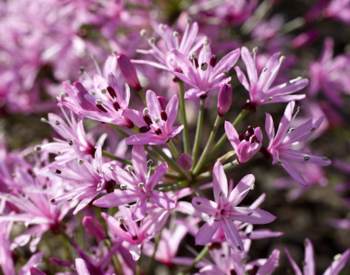
Description
Description
All Hessea species are small, deciduous and bulbous, reaching 50-250mm high when flowering. Mostly small, the bulbs have many, compactly layered tunics of a thick felt-like texture.
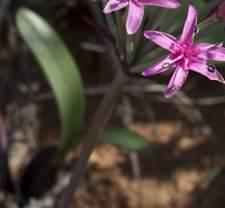
At maturity, the plants are two-leaved. Arranged opposite each other, the leaves are more or less erect to spreading and narrowly strap-shaped to linear. In most species the foliage is smooth, although Hessea incana and H. pilosula are minutely pilose. Surrounding the base of the green leaves is a bladeless, usually colourless sheath (a cataphyll) which most frequently remains below ground. Hessea breviflora is unusual, however, in having the cataphyll extended above ground as an attractive maroon-coloured sheath.
Hessea flowers are typically star-shaped and pale to deep pink, rarely white or pale yellow. Most are plain-coloured but three particularly attractive species ( H. cinnamomea, H. monticola and H. undosa ) have contrasting reddish colouring in the flower centre. The flowers are typically arranged on rigid pedicels that radiate outwards from the top of a short, naked scape (the main stem of the inflorescence). The overall effect is of a neat, small, open umbrella with the pedicels resembling the spokes and the closely set pink blooms providing the cover. Each flower has a short or rarely long, nectar-containing tube and six outspread to slightly recurved tepals. Hessea cinnamomea, H. monticola and H. undosa are unusual in having crisped tepals that give the flowers an appealing 'crinkly' look.
The six stamens have distinctive features in three of the species. Their filaments have inwardly curved appendages in Hessea mathewsii and H. pulcherrima , whereas in H. stenosiphon the three outer filaments are very short and the three inner filaments are long and somewhat club-shaped.

The ovary, which is inferior as in all Amaryllidaceae, has up to four ovules in each of its three chambers. The style is slender, ending in a shortly three-branched stigma.
The thin-walled capsules, formed after flowering, hold a few fleshy, reddish brown, egg-shaped seeds in which a large, green embryo is formed.
The basic chromosome number for Hessea is x = 11.
Conservation Status
Status
According to the current Red List of South African plants (Raimondo et al . 2009), five of the 14 species of Hessea face threats to their future survival. Of greatest concern is H. mathewsii, a Critically Endangered species which is likely to become extinct in the near future if current threats on the Cape's West Coast continue to prevail. As with the other four Red Listed species, the greatest threat facing the plants is habitat loss, due mainly to the unabated housing and agricultural developments in the Western Cape Province.
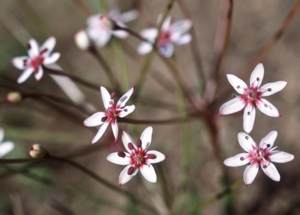
Distribution and habitat
Distribution description
All 14 species of Hessea are restricted to the winter and autumn rainfall regions of southern Africa. Based on available records, Hessea shows no marked centre of species richness within the distribution area. The most favoured habitats are seasonally moist sites provided by washes, depressions and areas receiving the run-off from rocks.
Derivation of name and historical aspects
History
The name Hessea commemorates Christian Heinrich Friedrich Hesse (1772–1837), a Lutheran minister who came to Cape Town from Hanover and grew succulents in his garden. He was appreciated for the hospitality he extended to numerous naturalists and travellers, one being Burchell to whom he gave an assortment of seeds, mostly of bulbous plants.
Although Hessea is closely related to the important horticultural genus Nerine, it has not gained the same favour due to its small size and short-lived inflorescences.
Ecology
Ecology
Hessea plants remain dormant over the dry summer season. Their flowers appear in autumn shortly after the first autumn showers and are a delight to see when little else is in bloom. In the fynbos species H. cinnamomea and H. monticola , flowering depends on wildfires to produce rarely seen, massed floral displays. The flowers attract various bees and short-tongued flies, mainly in search of nectar.
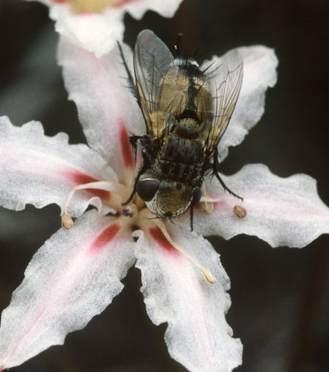
Flowering is brief and the inflorescences soon dry out, break loose from the bulbs and blow away, tumbling across the veld and dispersing their seeds en route. The seeds germinate almost immediately and give rise to robust seedlings which soon thrive during the wet winter months.
The species below reflect some of the variation within Hessea.
Growing Hessea
Grow
Because Hessea plants are not suited to general garden use the bulbs and seeds are difficult to obtain, other than at a few specialist bulb nurseries. Bulbs are best displayed as groups in pots filled with well-drained soil. It is vital to keep the bulbs dry during the dormant summer period.
Species
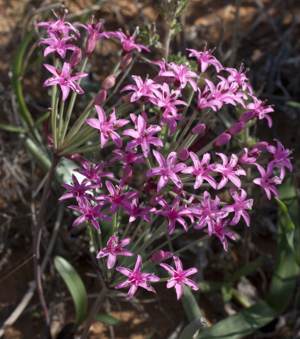
Hessea breviflora Herb.—Plants up to 200 mm high; bulb extended into a stout neck. Leaves 2(3), often emerging at flowering, 4–16 mm wide, shiny green, flushed with red basally, surrounded by a prominent brownish red sheath.
Flowers 10–55, star-shaped, 7–15 mm long, pale to deep pink, sometimes scented, stamens slightly shorter to longer than the tepals, spreading, fused into a 1.0–4.5 mm long filament tube. April–May.
Sandy pockets between rocks on lower slopes. Namaqualand, Olifants River valley to Hopefield.
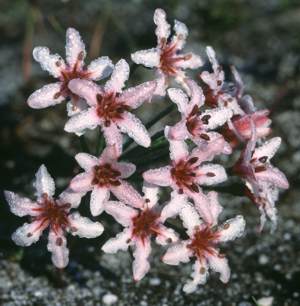
Hessea cinnamomea (L'Hér.) Durand & Schinz—Plants up to 150 mm high; bulb extended into a slender neck. Leaves (1)2, dry or emerging at flowering, 1.0–2.5 mm wide, dark shiny green.
Flowers 5–27, star-shaped, spreading to one side, widely funnel-shaped, 10–14 mm long, glistening white to pink with a wine-red centre, scented of spice, tepals crisped, stamens shorter than the tepals, filament tube up to 0.5 mm long. May–June, after fire.
Peaty soils. Lowlands of the south-western Cape.
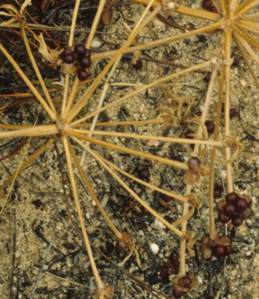
Hessea monticola Snijman—Plants up to 250 mm high; bulb with a long neck. Leaves usually 2, dry at flowering, 1.5–3.0 mm wide.
Flowers usually 10–30, star-shaped, white to pink with deep pink stripes leading down the throat, unpleasantly scented, tepals 10–25 mm long, with crisped edges, stamens shorter than the tepals, the filaments fused into a 1 mm long tube. March–May, usually after fire.
Rocky slopes or elevated, seasonally wet valleys. Piketberg and Cederberg to Houhoek Mountains.
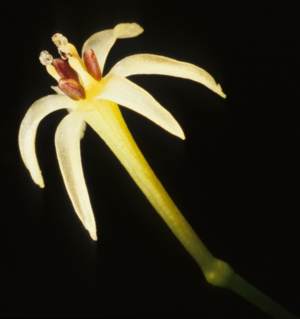
Hessea stenosiphon (Snijman) D. & U.Müll.-Doblies—Plants up to 200 mm high; bulb extended into a slender neck. Leaves 2 or rarely 3, dry at flowering, 1.0–3.5 mm wide.
Flowers 3–14, with a long, slender, greenish to reddish tube, 8–12 mm long, tepals narrow and recurved, 6–8 mm long, pale lemon, inner filaments appearing jointed, longer than outer filaments. April–May.
Seasonally moist rock crevices and soil pockets on granite domes. Kamiesberg Mountains.
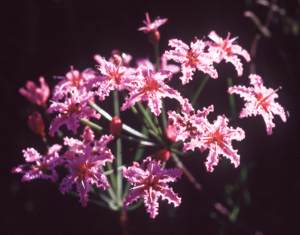
Hessea undosa Snijman—Plants up to 230 mm high; bulb with a slender neck. Leaves 2, dry at flowering, 1–2 mm wide.
Flowers 7–20, star-shaped, glistening pale to deep pink, with a reddish centre, scentless, tepals 6.5–8.0 mm long, with crisped edges, as long as the spreading stamens, the filaments fused into a basal tube up to 1 mm long. June–July.
Seasonally waterlogged sandstone rock pockets. Mountains near Vanrhynsdorp.
References
- Gunn, M. & Codd, L.E. 1980. Botanical exploration of southern Africa. Balkema, Cape town.
- Du Plessis, N. & Duncan, G. 1989. Bulbous plants of southern Africa, a guide to their cultivation and propagation. Tafelberg, Cape Town.
- Jackson, W.P.U. 1987. Origins and meanings of names of South African plant genera 1. Pteridophyta, Gymnosperms and monocotyledonous Angiosperms. University of Cape Town, Rondebosch.
- Manning, J., Goldblatt, P. & Snijman, D. 2002. The color encyclopedia of Cape bulbs. Timber Press, Cambridge.
- Raimondo, D., Von Staden, L., Foden, W., Victor, J.E., Helme, N.A., Turner, R.C., Kamundi, D.A. & Manyama, P.A. (eds) 2009. Red list of South African plants. Strelitzia 25. South African National Biodiversity Institute, Pretoria.
- Snijman, D.A. 1994. Systematics of Hessea , Strumaria and Carpolyza (Amaryllideae: Amaryllidaceae). Contributions from the Bolus Herbarium 16: 1–162.
Credits
Dee Snijman
Compton Herbarium
May 2014
Images: Copyright Colin Paterson-Jones
Plant Attributes:
Plant Type: Bulb
SA Distribution:
Soil type:
Flowering season:
PH:
Flower colour:
Aspect:
Gardening skill:
Special Features:
Horticultural zones






Rate this article
Article well written and informative
Rate this plant
Is this an interesting plant?
Login to add your Comment
Back to topNot registered yet? Click here to register.